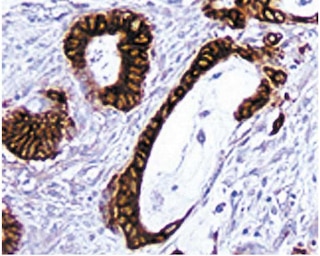Old Browser
This page has been recently translated and is available in French now.
Looks like you're visiting us from {countryName}.
Would you like to stay on the current country site or be switched to your country?




Analyses of RORγt Expression by Western bloting and Immunohistochemistry. Left Panel: Western blot analyses of RORγt expression by mouse splenocytes and thymocytes. Cell lysates from untreated mouse splenocytes (Spl; Lanes 1,2) and thymocytes (Thy; Lanes 3,4) (20 μg total cellular protein/lane) were electrophoresed (SDS-PAGE) and transferred to membranes. They were then probed with Purified Anti-Actin antibody (Cat. No. 612656/612657; Lanes 1,3 at 1 µg of antibody/ml) or Purified Mouse Anti-Mouse RORγt antibody (Clone Q31-378; Cat. No. 562663; Lanes 2,4 at 1 µg/ml). Mouse RORγt is identified as a protein band of ~56 kDa in the thymocyte lysate whereas actin is detected as ~42 kDa bands in the splenocyte and thymocyte lysates. Middle Panel: Immunohistochemical analysis of RORγt expressed in mouse thymocytes. Following antigen retrieval with BD Retrievagen A Buffer (Cat. no. 550524), the formalin-fixed paraffin-embedded sections were stained with either Purified Mouse IgG2a, κ Isotype Control (Cat. No. 550339; Left Image) or Purified Mouse Anti-RORγt antibody (Q31-378; Right Image). This was followed by staining with Biotin Rat Anti-Mouse IgG2a secondary antibody (Cat. No. 550332), Streptavidin HRP (Cat. No. 550946) and a DAB Substrate Kit (Cat. No. 550880) with Hematoxylin counterstaining. The RORγt staining is nuclear as shown in the figures. Original magnification: 20x. Right Panel: Immunohistochemical analysis of RORγt expressed in mouse small intestine. Sections of mouse small intestine were similarly stained for immunohistochemical analysis. Original magnification: 20x.


BD Pharmingen™ Purified Mouse anti-Mouse RORγt

Regulatory Status Legend
Any use of products other than the permitted use without the express written authorization of Becton, Dickinson and Company is strictly prohibited.
Preparation And Storage
Product Notices
- Since applications vary, each investigator should titrate the reagent to obtain optimal results.
- Please refer to www.bdbiosciences.com/us/s/resources for technical protocols.
- Sodium azide is a reversible inhibitor of oxidative metabolism; therefore, antibody preparations containing this preservative agent must not be used in cell cultures nor injected into animals. Sodium azide may be removed by washing stained cells or plate-bound antibody or dialyzing soluble antibody in sodium azide-free buffer. Since endotoxin may also affect the results of functional studies, we recommend the NA/LE (No Azide/Low Endotoxin) antibody format, if available, for in vitro and in vivo use.
- Caution: Sodium azide yields highly toxic hydrazoic acid under acidic conditions. Dilute azide compounds in running water before discarding to avoid accumulation of potentially explosive deposits in plumbing.
- An isotype control should be used at the same concentration as the antibody of interest.
Companion Products






The Q31-378 monoclonal antibody recognizes mouse RORgamma t (RORγt), an isoform of RORgamma (RORγ). RORγt is a DNA-binding transcription factor that belongs to the ROR/RZR orphan nuclear receptor family. RORγt is expressed exclusively by lymphoid cells including CD4+CD8+ thymocytes, peripheral CD4+ Th17 and CD8+ Tc17 cells, NKT cells and innate lymphoid cells such as lymphoid tissue inducer (LTi) cells. RORγt plays essential roles in thymopoiesis, T cell homeostasis, differentiation of effector T lymphocytes and the development of secondary lymphoid tissues including lymph nodes and Peyer's patches.
Development References (9)
-
Bechtel S, Rosenfelder H, Duda A, et al. The full-ORF clone resource of the German cDNA Consortium. BMC Biochem. 2007; 8:399-410. (Biology). View Reference
-
Eberl G, Littman DR. The role of the nuclear hormone receptor RORgt in the development of lymph nodes and Peyer's patches. Immunol Rev. 2003; 195(195):81-90. (Biology). View Reference
-
Eberl G, Marmon S, Sunshine MJ, Rennert PD, Choi Y, Littman DR. An essential function for the nuclear receptor RORgamma(t) in the generation of fetal lymphoid tissue inducer cells. Nat Immunol. 2004; 5(1):64-73. (Biology). View Reference
-
Hamada H, Garcia-Hernandez MdlL, Reome JB, et al. Tc17, a unique subset of CD8 T cells that can protect against lethal influenza challenge. J Immunol. 2009; 182(6):3469-3481. (Biology). View Reference
-
He YW, Deftos ML, Ojala EW, Bevan MJ. RORgamma t, a novel isoform of an orphan receptor, negatively regulates Fas ligand expression and IL-2 production in T cells. Immunity. 1998; 9(6):797-806. (Biology). View Reference
-
Hirose T, Smith RJ, Jetten AM. ROR gamma: the third member of ROR/RZR orphan receptor subfamily that is highly expressed in skeletal muscle. Biochim Biophys Acta. 1994; 205(3):1976-1983. (Biology). View Reference
-
Ivanov, II, McKenzie BS, Zhou L, et al. The orphan nuclear receptor RORgammat directs the differentiation program of proinflammatory IL-17+ T helper cells. Cell. 2006; 126(6):1121-1133. (Biology). View Reference
-
Medvedev A, Yan ZH, Hirose T, Giguere V, Jetten AM. Cloning of a cDNA encoding the murine orphan receptor RZR/ROR gamma and characterization of its response element. Gene. 1996; 181(1-2):199-206. (Biology). View Reference
-
Unutmaz D. RORC2: the master of human Th17 cell programming. Eur J Immunol. 2009; 39(6):1452-1455. (Biology). View Reference
Please refer to Support Documents for Quality Certificates
Global - Refer to manufacturer's instructions for use and related User Manuals and Technical data sheets before using this products as described
Comparisons, where applicable, are made against older BD Technology, manual methods or are general performance claims. Comparisons are not made against non-BD technologies, unless otherwise noted.
For Research Use Only. Not for use in diagnostic or therapeutic procedures.
Report a Site Issue
This form is intended to help us improve our website experience. For other support, please visit our Contact Us page.